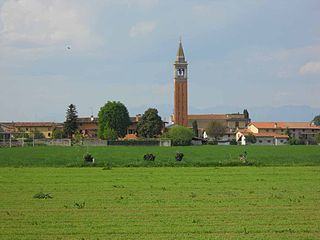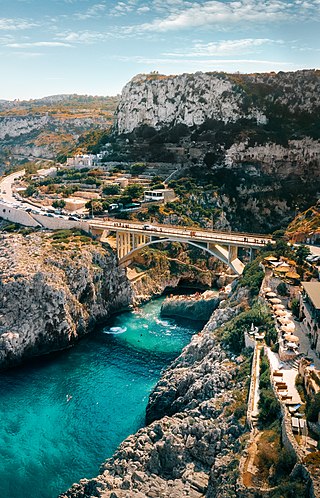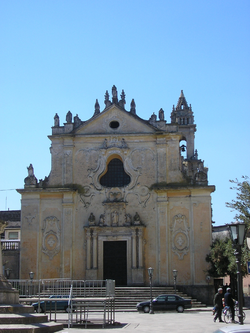
Apulia, also known by its Italian name Puglia, is a region of Italy, located in the southern peninsular section of the country, bordering the Adriatic Sea to the east, the Strait of Otranto and Ionian Sea to the southeast and the Gulf of Taranto to the south. The region comprises 19,345 square kilometers (7,469 sq mi), and its population is about four million people. It is bordered by the other Italian regions of Molise to the north, Campania to the west, and Basilicata to the southwest. The regional capital is Bari.

Otranto is a coastal town, port and comune in the province of Lecce, in a fertile region once famous for its breed of horses. It is one of I Borghi più belli d'Italia.

Salento, is a cultural, historical, and geographic region at the southern end of the administrative region of Apulia, in southern Italy. It is a sub-peninsula of the Italian Peninsula, sometimes described as the "heel" of the Italian "boot". It encompasses the entire administrative area of the Province of Lecce, most of the Province of Brindisi, and the south-eastern part of the Province of Taranto.

Martano is a town and comune of 9,573 inhabitants in the province of Lecce in Apulia, Italy, 20 kilometres (12 mi) from Lecce and 18 kilometres (11 mi) from Otranto. It is the biggest town of Grecìa Salentina, an area where some inhabitants, in addition to Italian and Salentino can also speak a greek dialect called Griko.

Pietramontecorvino is a town and comune in the province of Foggia in the Apulia region of southeast Italy. It is located in the Monti Dauni, on a rocky spur commanding the valley of the Triolo, a right tributary of the Candelaro river. It is one of I Borghi più belli d'Italia.

Vico del Gargano is a village and comune in the province of Foggia in the Apulia region of southeast Italy. Called the "Village of Love", it is part of the Gargano National Park and the Mountain Community of Gargano.
Castrignano del Capo is a town and comune in the province of Lecce in the Apulia region of south-east Italy. It has three Villages: Santa Maria di Leuca, Giuliano, Salignano.

Gagliano del Capo is an Italian comune situated in the province of Lecce, the southernmost one of Apulia.

Maglie is a town and comune in the province of Lecce in the Apulia region of southeast Italy.
Miggiano is an Italian city of 3,702 inhabitants in the province of Lecce in Apulia. Located in the lower Salento, a few kilometres from the Adriatic coast, it lies 50 kilometres (31 mi) from the chief town and 22 kilometres (14 mi) from Santa Maria di Leuca. Formerly considered a town, in 2003 Miggiano was elevated to the status of City.

Morciano di Leuca is a town and comune of 3,121 inhabitants in the province of Lecce, in the Apulia region of south-east Italy.

Santa Cesarea Terme is a town and comune in the province of Lecce, Apulia, southern Italy.

Minervino di Lecce is a town and comune in the province of Lecce, Apulia, south-eastern Italy. It is situated in the eastern part of the Salento peninsula about 43 kilometres (27 mi) from Lecce, not far from Otranto.

Salve is a town and comune of 4,546 inhabitants of the province of Lecce, in the region of Apulia, south-east Italy.

Bicinicco is a comune (municipality) in the Regional decentralization entity of Udine in the Italian region of Friuli-Venezia Giulia, located about 50 kilometres (31 mi) northwest of Trieste and about 15 kilometres (9 mi) south of Udine.

Santa Maria la Longa is a comune (municipality) in the Regional decentralization entity of Udine in the Italian region of Friuli-Venezia Giulia, located about 50 kilometres (31 mi) northwest of Trieste and about 15 kilometres (9 mi) southeast of Udine.

Santa Maria di Leuca, often spelled simply Leuca is a frazione of the comune of Castrignano del Capo, in the Salento peninsula (Apulia), southern Italy. A part of the town once belonged to the comune of Gagliano del Capo.

Lecce railway station serves the city and comune of Lecce, in the region of Apulia, Southern Italy. Opened in 1866, it is the southern terminus of the Adriatic Railway (Ancona–Lecce), and is also the terminus of two regional lines, the Martina Franca–Lecce railway and the Lecce–Otranto railway.

The Terra di Otranto, or Terra d'Otranto, is an historical and geographical region of Apulia, largely corresponding to the Salento peninsula, anciently part of the Kingdom of Sicily and later of the Kingdom of Naples, which became a province of the Kingdom of the Two Sicilies.

Ciolo is a narrow coastal inlet and a site of historical and environmental interest, which is located in the south of Apulia, in the historical region of Salento, Italy. The location is also known as a geological site and for the presence of numerous sea caves, the largest one being the Grotta del Ciolo. Since October 2006 the Ciolo's area has become part of the Regional Park "Costa Otranto - Santa Maria di Leuca e Bosco di Tricase", created by the Apulia region to protect the eastern coast of Salento, specifically the architectural assets as well as important animal and plant species.
























